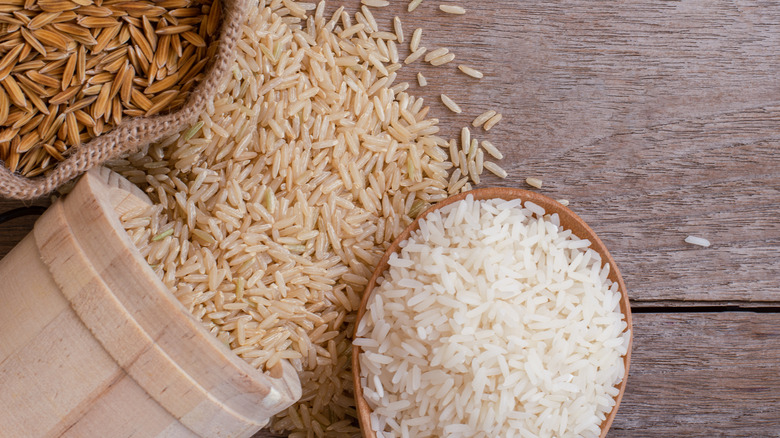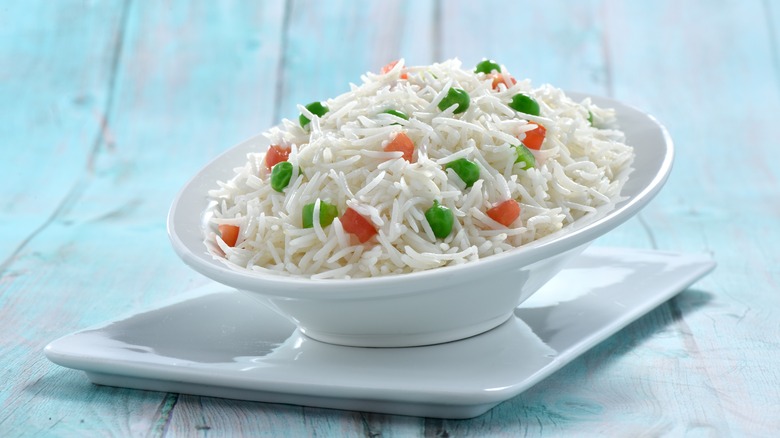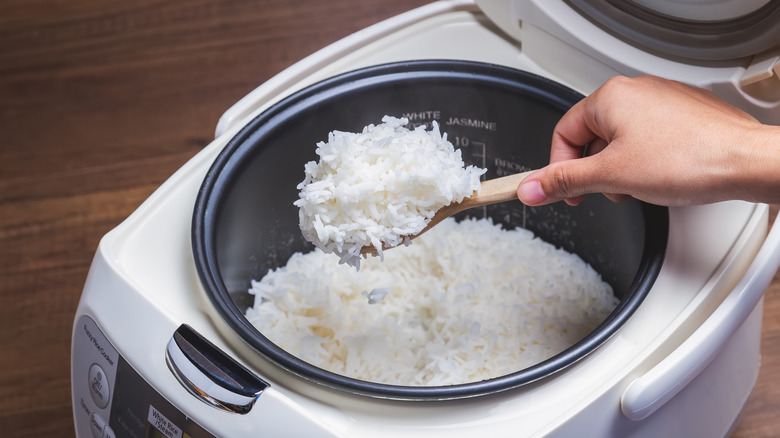What's The Difference Between Basmati And Jasmine Rice?
Rice is everywhere. Originating in China as far back as 7000 B.C., and spreading soon after into Japan and Korea, this hardworking grain is now a universal side starch to many plates, states UCL. In fact, according to Harvard University's School of Public Health, this vital grain has specialties in different countries depending on local ingredients and favored flavors, like jambalaya in the southern states of the U.S., paella in Spain, risotto in Italy, coconut rice in Colombia, steamed rice in China, sticky rice in Japan, rice and beans in Mexico, sweet rice in Portugal, and many more, with the varieties of rice being a whole other story.
According to The Forked Spoon, you've got short-grain, medium-grain, and long-grain rice varieties. Short-grain rice types are called Japanese short-grain, Bomba rice, Chinese black rice, and short-grain glutinous rice; then there are medium-grain rice types known as carnaroli, vialone nano, calrose, and arborio (which is the go-to type of rice for making risotto); and lastly, you have long-grain rice, which of course, consists of the two we're discussing in detail, which is jasmine and basmati. These two types of rice look very similar, which is the reason many assume they work the same way and can be interchangeable, but this isn't necessarily true.
More about basmati rice
Originating in the Himalayas, India, and Pakistan, basmati rice comes in white and brown varieties and is typically used in pilaf, or as a side dish to soups and curries, states The Spruce Eats. With a subtle nutty flavor and scent of florals, this long-grain rice actually has extra-long, thin grains, which require further soaking before cooking to remove excess starches, compared to other types. According to Greatist, basmati has a firm, chewy, slightly drier texture.
Nutritionally, according to Healthline, basmati rice is high in carbohydrates and calories, which may seem like a downside, but it's the number of micronutrients, such as folate, thiamine, and selenium, that helps with healthy cell formation, prevents cell damage and infections and is a necessary nutrient in early pregnancy to prevent birth defects (per Mayo Clinic).
Rice tends to have higher amounts of arsenic, which becomes a risk when incorporating it into your daily diet. However, white varieties of basmati have some of the lowest levels of arsenic, as it accumulates onto the hard outer bran layer of the grain, compared to brown basmati rice.
More about jasmine rice
Known as "Thai fragrant rice," WebMD states that jasmine rice is a type of long-grain rice originating from Thailand, and comes in white, brown, red, purple, and black varieties, with white being most commonly produced. According to Fine Dining Lovers, jasmine rice is known for having a slightly sweet flavor and a subtle scent of popcorn. Its grains aren't quite as long as basmati rice, making jasmine's texture a bit more fluffy and light, and requiring less time soaking before cooking. This grain gets its name from its color, which closely resembles a jasmine flower. According to Greatist, jasmine rice is best steamed, compared to basmati's go-to method of boiling.
The Spruce Eats states that jasmine rice is the best rice variety for serving up as a starchy side to stir-fries, grilled or fried meat, stews, or even soups. Nutritionally, jasmine rice is higher in carbohydrates and calories (per SF Gate). However, WebMD states that its micronutrients such as folate, magnesium, phosphorus, selenium, manganese, and vitamin B6, provide major health benefits such as an improved immune system, a healthier pregnancy, and even help digestion.


